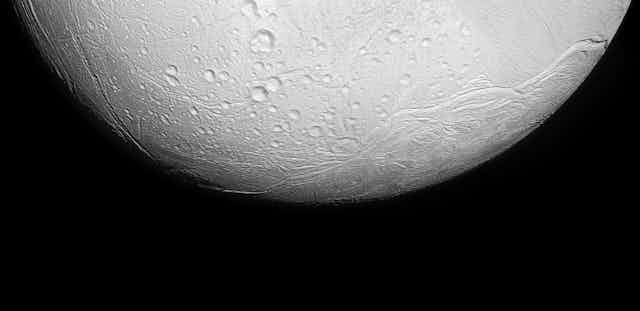Finding liquid water on a celestial body within the solar system is exciting. The only thing that is probably more exciting is finding an ocean full of it. Today such news comes via Cassini, which has made measurements that show that Saturn’s moon Enceladus has a hidden ocean beneath its icy surface.
While orbiting Saturn in 2005, Cassini found jets of salty water spewing from the south polar region of Enceladus. According to Luciano Iess of Sapienza University of Rome, lead author of the new study published in Science, “The discovery of the jets was unexpected.”
Geysers require liquid water, and we wouldn’t expect Enceladus to have any. It is too far from the Sun to absorb much energy and too small (just 500km in diameter) to have trapped enough internal energy to keep its core molten. The answer to how the water got there might lie in the details of the moon’s internal structure.
Water beneath an icy crust
The data to understand Enceladus’s internal structure came from by measuring changes in Cassini’s speed as it flew close to the moon. When passing the denser parts of the moon, it sped up by a few extra thousandths of a metre per second. That minute change was tracked through recordings of the radio signals Cassini was sending to NASA’s Deep Space Network station.
In making such tiny measurements, scientists had to filter out other factors that could influence Cassini’s speed. These include pressure on the spacecraft from sunlight, the nudge from heat radiating from its nuclear-powered electrical generator, and the drag of the particles it strikes as it passes through the south polar plumes.
Iess and his colleagues have produced a model of the internal structure of Enceladus using the measurements. They conclude that there is a core that is roughly 200km in diameter; above that lies a 10km-thick layer of liquid water, which is followed by 40km of ice crust. The water layer may extend all the way to the north pole, but its thickest part lies at the south pole.

It is possible that Saturn’s powerful gravity is responsible for the liquid water under Enceladus’s surface. Its pull could heat up the interior through a process called tidal kneading, which creates tides in the ocean causing internal friction and thus heat.
After the initial discovery of the plumes, Cassini’s minders put a lot of effort into determining Enceladus’s internal structure, but it still took nearly ten years to do so. This is because the time the spacecraft spends around Saturn is very valuable, and there are lots of other things worth studying.
Cassini can only make a handful of flybys near Enceladus while still paying attention to other moons, such as Titan. When approaching Enceladus, the controllers also had to make a choice about how to study the moon because of a limitation in how Cassini’s instruments are arranged. When making gravitational recordings it needs to point its antenna towards Earth, but in doing so all its other instruments face away from Enceladus. Of the 19 flybys, only three were used to make gravitational recordings.
“After spending eight years in the Saturnian system, one may think that the measurements are becoming repetitive and that Cassini has discovered everything in the reach of its instruments. This is far from being true,” Iess said.
Time is running out
“The evidence adds up to a large and active body of water under Enceladus’s southern polar region”, Helen Maynard-Casely of Australian Nuclear Science and Technology Organisation said. But she warned, “It is going to be a long time before we can verify if this ocean is there, if ever.”
The plutonium-powered spacecraft has enough energy to power itself till 2017. The trouble is that, in three years, it will only be able to make three more flybys of Enceladus, which is not enough to take more gravity data. Its end is slated to come when controllers drive it into Saturn’s atmosphere for incineration, because scientists are keen to avoid having it crash into Saturn’s pristine moons.
There is a push to send another mission to Saturn, but Jupiter’s moon Europa might be a better candidate to search for life. At 3,100km in diameter, it is much larger than Enceladus, and, in December, astronomers spotted water vapour coming from its south pole, as well.
The possibility of finding a large amount of liquid water is exciting because, for life to exist as we understand it, we need liquid water. Even on Earth, whenever untouched sources of liquid water, such as Lakes Vostok and Ellsworth under Antarctica, are studied, there is always the hope that we may discover new forms of life.

